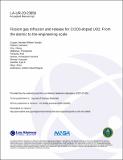Fission Gas Diffusion and Release for Cr 2 O 3 -Doped UO 2: From the Atomic to the Engineering Scale
Author(s)
Cooper, Michael WD; Pastore, Giovanni; Che, Yifeng; Matthews, Christopher; Forslund, Axel; Stanek, Christopher R; Shirvan, Koroush; Tverberg, Terje; Gamble, Kyle A; Mays, Brian; Andersson, David A; ... Show more Show less
DownloadAccepted version (1.472Mb)
Publisher with Creative Commons License
Publisher with Creative Commons License
Creative Commons Attribution
Terms of use
Metadata
Show full item recordAbstract
© 2020 The anticipated benefits of large grains in Cr2O3-doped UO2 pellets include improved mechanical and fission gas retention properties. To support the assessment of fission gas release (FGR) from doped pellets, the impact of doping on fission gas diffusivity for in-reactor conditions must be understood. In this work, we tackle this issue by informing the fission gas model within the BISON fuel performance code using material models developed at the atomic scale. The investigation of intra-granular fission gas diffusivity in Cr2O3-doped UO2 is carried out by adapting a cluster dynamics model that, accounting for UO2 thermochemistry, is capable of describing Xe diffusion under irradiation in undoped UO2 as the starting point. Using a thermodynamic analysis, it is shown that in stoichiometric UO2 with additions of Cr2O3, the oxygen potential is defined by the Cr-Cr2O3 two-phase equilibrium. Using the cluster dynamics model, the predicted Xe diffusivity in doped UO2 was significantly increased in both the intrinsic and irradiation-enhanced regimes compared to undoped UO2, as a result of higher concentrations of uranium and oxygen vacancies, respectively. This is a consequence of the more oxidizing conditions at high temperature, and more reducing conditions at low temperature, as a result of doping. Arrhenius functions have been fitted to the cluster dynamics results to enable implementation of the new diffusivities in the BISON fission gas behavior model. BISON simulations were carried out, showing the competing effects of the enlarged grains and the new fission gas diffusivity model, which act to suppress and enhance fission gas release, respectively. The new physics-informed model was validated against in-reactor experimental measurements under normal operation. Additionally, benchmarking was carried out for power ramp conditions. The predicted fission gas release agreed well with the experimental data, showing noticeable improvements over the standard UO2 model.
Date issued
2021Department
Massachusetts Institute of Technology. Department of Nuclear Science and EngineeringJournal
Journal of Nuclear Materials
Publisher
Elsevier BV
Citation
Cooper, Michael WD, Pastore, Giovanni, Che, Yifeng, Matthews, Christopher, Forslund, Axel et al. 2021. "Fission Gas Diffusion and Release for Cr 2 O 3 -Doped UO 2: From the Atomic to the Engineering Scale." Journal of Nuclear Materials, 545.
Version: Author's final manuscript